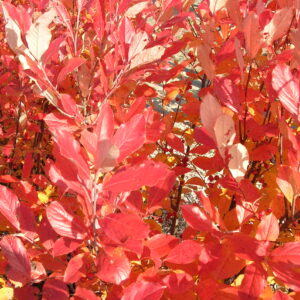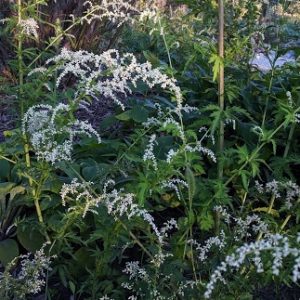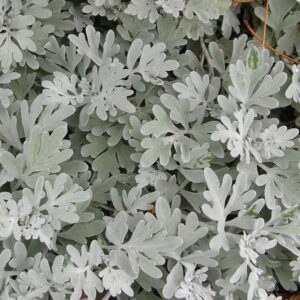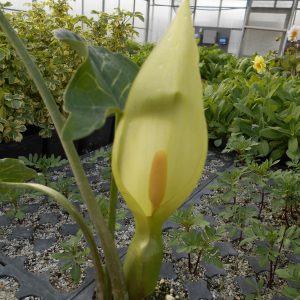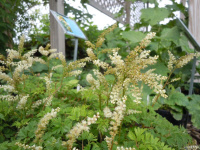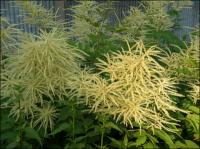Our Plants
Showing 57–64 of 587 results
-
Aronia arbutifolia Red chokeberry syn. Photinia pyrifolia SHRUB Z 5-9
Corymbs of white in spring, gorgeous red foliage in fall compliments the red berries that persist into winter
OUT OF STOCK
Corymbs of white in spring, gorgeous red foliage in fall compliments the red berries that persist into winter
Size: 6-8' X 3-5'
Care: sun to part shade in moist to well-drained acidic soil. Prune annually in late winter to promote vigorous growth.
Native: Nova Scotia west to Ontario south to TX & FL
Wildlife Value: Berries overwinter-food for Thrush, Oriole, and Cedar waxwings.Showy shrub collected by André Michaux around 1800. Aronia comes from aria a subgenus of a related plant, Sorbus. Arbutifolia means “leaves like the Arbutus.” William Robinson, father of mixed borders, reported: “Massed, charming both in flower and fine color of leaf in autumn.”
-
Artemisia frigida Prairie sagewort, Silky wormwood Z 3-10
Erect stems bear silvery-white, finely-divided foliage. Leaves smell like camphor. Inconspicuous yellow flowers bloom in summer.
OUT OF STOCK – EMAIL FOR AVAILABILITY
Erect stems bear silvery-white, finely-divided foliage. Leaves smell like camphor. Inconspicuous yellow flowers bloom in summer.
Size: 6-18” x 12-18”
Care: sun in well-drained soil. Drought tolerant.
Native: all North America except the SE, CA and OR, Wisconsin native
Wildlife Value: source of nesting material for native bees, food for caterpillars of several butterflies & moths
Awards: Royal Horticultural Society Award of Garden MeritNative Americans used this Artemisia to preserve meat, feed horses, repel insects, to remedy toothache, headache, coughing, lung ailments, heartburn, and colds. Indians in Great Basin used it in ceremonies. Chippewa made a decoction of root for convulsions. For the Lakota this was “women’s medicine” with an infusion helping regulate menstrual periods and induce contractions in pregnancy.
Meriwether Lewis collected this along the Missouri River in South Dakota on October 3, 1804. -
Artemisia lactiflora White mugwort Z 3-8
Plumes of creamy white, resembling an astilbe, above foliage blackish-green on one side and silver on the other side, Blooms August to October
OUT OF STOCK – EMAIL FOR AVAILABILITY
Blooms in plumes of creamy white, resembling an astilbe, above foliage blackish green on one side and silver on the other side. Blooms August to October.
Size: 4-5’ x 1.5-2’
Care: sun to part shade in moist, well-drained soil.
Native: East asia-China
Wildlife Value: attracts butterflies & bees. Rabbit and Deer tolerant
Awards: Royal Horticultural Society Award of Garden MeritGenus is named for Artemis, Greek goddess of the moon, wild animals, and hunting. Lactiflora means “milk-white flowers”
Used in traditional Chinese medicine to treat menstrual & liver disorders, and reduce inflammation. Southeast Asians cook with its leaves and tender stems boiled or stir fried and added to soups. 1st described in Western literature 1837.
-
Artemisia stellerana Beach wormwood, Dusty miller Z 3-7
Intricate, embroidery-like, felty-white foliage
Grown for its intricate, embroidery-like, felty-white foliage
Can not ship to: Maryland
Size: 24” x 12”
Care: sun in moist well-drained to dry soil
Native: naturalized in North America from Massachusetts to DelawareArtemisia named for the wife of Mausolus, king of Caria, who began using another Artemisia. Miller 1768. Collected from the wild by 1842. Recommended by Gertrude Jekyll to use on the edges of gardens, 1908 L.H. Bailey (1933) described it as “attractive for its whiteness. Useful for borders.”
**LISTED AS OUT OF STOCK BECAUSE WE DO NOT SHIP THIS ITEM. IT IS AVAILABLE FOR PURCHASE AT OUR RETAIL LOCATION.
-
Arum italicum Cuckoo plant, Lords and ladies Z 5-9
“The leaves of this sort rise a foot and a half high, are very large, running out to a point; these are finely veined with white, interspersed with black spots, which, together with the fine shining green of their surface, make a pretty variety. The flowers grow near a foot high, and have long upright spaths, which are of a pale green, inclining to white; these appear the end of April, or beginning of May, and the seeds are ripe in August.” Phillip Miller’s Gardeners Dictionary, 1768. (seeds are poison)
“The leaves of this sort rise a foot and a half high, are very large, running out to a point; these are finely veined with white, interspersed with black spots, which, together with the fine shining green of their surface, make a pretty variety. The flowers grow near a foot high, and have long upright spaths, which are of a pale green, inclining to white; these appear the end of April, or beginning of May, and the seeds are ripe in August.” Phillip Miller’s Gardeners Dictionary, 1768. (seeds are poison)
Can not ship to: Maryland
Size: 10-15”x 8"
Care: Shade to part shade in moist well-drained soil
Native: Italy, Spain, Britain, and Portugal.
Awards: Royal Horticultural Society Award of Garden MeritIdentified by Pedianus Dioscordies (40 – 90) in De Materica Medica for medicinal use around 70 A.D. “Showy,” according to William Robinson (1933.)
-
Aruncus aethusifolius Dwarf goat’s beard Z 3-8
You know the fireworks they display at the end of the night, with light bursting every direction from a center? These flowers resemble a tiny version of that, emerging in spring and early summer above a compact mound of fern-like foliage
You know the fireworks they display at the end of the night, with light bursting every direction from a center? These flowers resemble a tiny version of that, emerging in spring and early summer above a compact mound of fern-like foliage. Good foil for solid, paddle-like leaves of Bergenia.
Size: 10" x 12-18"
Care: part shade to shade in moist to well-drained soil
Native: Korea
Awards: Elizabeth Carey Miller Botanical Garden Great Plant Pick.Described in 1912 by Japanese botanist who explored Korea for plants, Takenoshin Nakai (1882-1952)
-
Aruncus dioicus syn. Spiraea aruncus, Aruncus sylvester Goat’s beard Z 3-7
Bold cream-colored arching plumes in early to mid-summer, light up shady corners.
Bold cream-colored arching plumes in early to mid-summer, light up shady corners.
Size: 5-6' x 4'
Care: part to full shade, moist to moist well-drained soil
Native: Europe, E. Siberia, E. North America
Awards: Royal Horticultural Society Award of Garden MeritGrown by Tradescant in England by 1633. Sold in America’s 1st plant catalog, Bartram’s Broadside, 1783. In 1870 William Robinson recommended growing the plant for naturalization. Robinson described it as: “beautiful in foliage and habit as well as flower…flowers are freely produced in summer in large gracefully-drooping plumes.”
-
Asarum canadense syn. Hexastylis canadense Wild ginger Z 3-7
Concealed brown bell-shaped flowers with flared tips hide under this groundcover's crinkled, lacquered leaves.
Concealed brown bell-shaped flowers with flared tips hide under this groundcover’s lacquered leaves.
Size: 6" x 6" spreading
Care: part shade to shade, moist well-drained to well-drained soil
Native: Canada to So. Carolina, Wisconsin nativeNative Americans used Wild ginger for such diverse purposes as flavoring food, curing heart palpitations, induce menstrual cycles, cure “the bite of the serpent,” mend broken bones, as a general tonic, a tea and lure catfish. Winnebago tenderized raccoon meat with this. Colonists used the plant to break fever and stimulate the appetite. Studies in the last 50 years have showed that the roots contain antibiotics BUT also can damage kidneys and are possibly carcinogenic.

